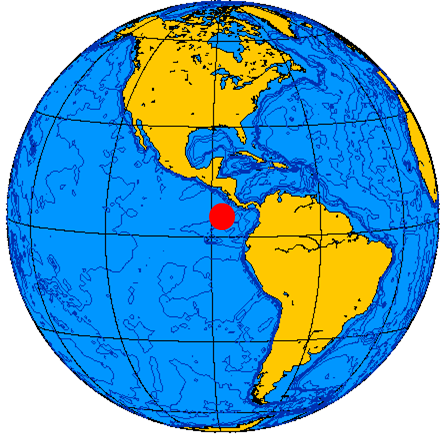On Cocos Island in the eastern Pacific, a “treasure” consisting of works created by 40 modern artists is buried. The exact location is described in an encrypted message. To my knowlege, this cryptogram has never been published.
Stories about hidden treasures are well known among crypto history enthusiasts. Blog reader Dampier has recently made me aware of one that is not yet mentioned in the crypto literature: the Treasure of Lima.
The Treasure of Lima
Here’s the background story (for more information check Wikipedia):
When in 1820 the city of Lima, Peru, was on the edge of revolt, it was decided to transport the city’s most valuable items to Mexico for safekeeping. A Captain William Thompson was put in charge of transporting these riches on a ship named Mary Dear. Thompson and his crew couldn’t resist the temptation and turned pirate. They killed the accompanying priests and headed for Cocos Island in the Eastern Pacific, where the men buried the treasure.

Source: Wikimedia
Later, the Mary Dear was captured, and the crew went on trial for piracy. All but Thompson and his first mate were hanged. To save their lives, the two agreed to lead the Spanish to the stolen treasure. They took them as far as the Cocos Island and then managed to escape into the jungle. The two men and the treasure were never seen again.
Though it is far from clear whether this story is authentic, hundreds of treasure hunters have travelled to Cocos Island and tried to find the Treasure of Lima. Apparently, none of them was successful. Meanwhile, the local government has declared treasure hunting on Cocos Island illegal.
Treasure of Lima: A Buried Exhibition
In 2014, an art project titled Treasure of Lima: A Buried Exhibition was started. The project team buried a container with artworks created by 40 different artists in a secret location in Cocos Island. The coordinates of the hiding place were encrypted and sold in an auction.
Since 2014 nothing new seems to have been published about Treasure of Lima: A Buried Exhibition. So I ask myself:
- Who purchased the encrypted coordinates?
- Has this cryptogram ever been published?
- Has the cryptogram ever been broken?
- Has the buried container ever been found?
Does a reader know more about this nice story? If so, please leave a comment.
Follow @KlausSchmeh
Further reading: Four cryptograms from a 1930s treasure hunt
Linkedin: https://www.linkedin.com/groups/13501820
Facebook: https://www.facebook.com/groups/763282653806483/



Kommentare (5)